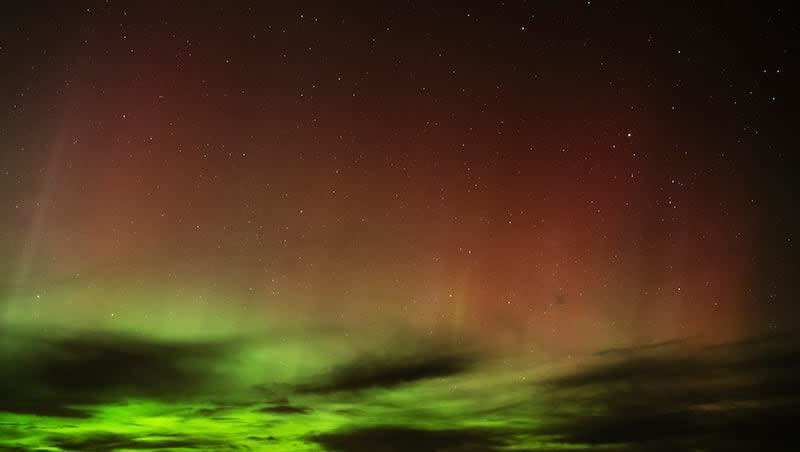A solar storm is hitting Earth this weekend, bringing views of the northern lights to the U.S.

One of the strongest solar storms in nearly two decades is forecasted to hit Earth on Friday, bringing with it views of the northern lights across the United States, per The Weather Channel.
In addition to colorful views, the storm could also disrupt radio communication, satellite systems and power grids. On Thursday, the National Oceanic and Atmospheric Administration issued a geomagnetic storm warning. The NOAA has observed the start of the storm but has not yet detected any disruption in communications.
“Over the past few days, the sun has launched massive clouds of charged particles toward the Earth, events known as coronal mass ejections (CMEs),” reports AccuWeather. “When these hit Earth’s magnetic field, they will ignite the aurora borealis over the Northern Hemisphere and the aurora australis over the Southern Hemisphere.”
If the storm holds its strength, views of the northern lights will be visible across the majority of the United States.
Large sunspot groups and strong solar flares led to the issuance of SWPC's first G4 Watch since 2005... pic.twitter.com/oi55cTPXhP
— NOAA Space Weather Prediction Center (@NWSSWPC) May 9, 2024
What are the northern lights?
The northern lights, also known as aurora borealis, are colorful ribbons of light in the sky that provide a cosmic show for viewers. They are the result of a violent event in the Earth’s atmosphere.
“The northern lights are created when energized particles from the sun slam into Earth’s upper atmosphere at speeds of up to 45 million mph (72 million kph), but our planet’s magnetic field protects us from the onslaught,” per Space.
“As Earth’s magnetic field redirects the particles toward the poles — there are southern lights, too, which you can read about below — the dramatic process transforms into a cinematic atmospheric phenomenon that dazzles and fascinates scientists and skywatchers alike.”
Northern lights are most common in the “auroral zone” — the area in an approximately 1,550-mile radius of the North Pole, per Space. The northern most parts of Alaska, Canada, Sweden, Norway, Finland and all throughout Iceland are the places you are most likely to see the northern lights.
Where will you be able to see the northern lights in the U.S.?
This weekend, the northern lights may be visible from Montana to Alabama, though views will differ, per The Weather Channel. The auroras will be more visible in the northern U.S., but even in the deep south the auroras will be visible on the horizon.
“The aurora may be visible to the naked eye as far south as Virginia, Missouri, Colorado and Northern California on Friday night into early Saturday morning,” reports AccuWeather. “The best viewing conditions are expected across the northern Plains and the Pacific Northwest, where mainly cloud-free conditions will lead to great views of the night sky.”
States with the highest visibility include:
Washington.
Oregon.
Idaho.
Montana.
Colorado.
North Dakota.
South Dakota.
Minnesota.
Wisconsin.
Michigan.
New York.
Vermont.
New Hampshire.
Maine.
The map below demonstrates what visibility be like in every region of the U.S.
🚨#BREAKING: Much of the Northern United States has a chance to See Northern Lights as Level G4 Severe geomagnetic hits in nearly two decades
📌#UnitedStates | #USA
A series of powerful severe geomagnetic storms are expected to hit Earth tonight into Saturday, affecting much of… pic.twitter.com/iX4b4VwokU— R A W S A L E R T S (@rawsalerts) May 10, 2024
The geomagnetic storm could disrupt communications
On Thursday, the U.S. government issued a severe geomagnetic storm watch — the first in roughly 20 years.
“Geomagnetic storms can impact infrastructure in near-Earth orbit and on Earth’s surface, potentially disrupting communications, the electric power grid, navigation, radio and satellite operations,” reports the NOAA. “SWPC has notified the operators of these systems so they can take protective action.”
During the last decade, engineers have built technology that can protect power lines during geomagnetic storms, so it is likely our communications will not be disrupted, per The Washington Post.
Shawn Dahl, the service coordinator for the NOAA’s Space Weather Prediction Center, recommended that people take the same precautions they would with any severe storm, such as making sure they have batteries or a generator.
“They don’t need to do anything out of the extraordinary,” Dahl told The Washington Post, “if they’ve already got these measures taken care of, because these events are very rare.”

